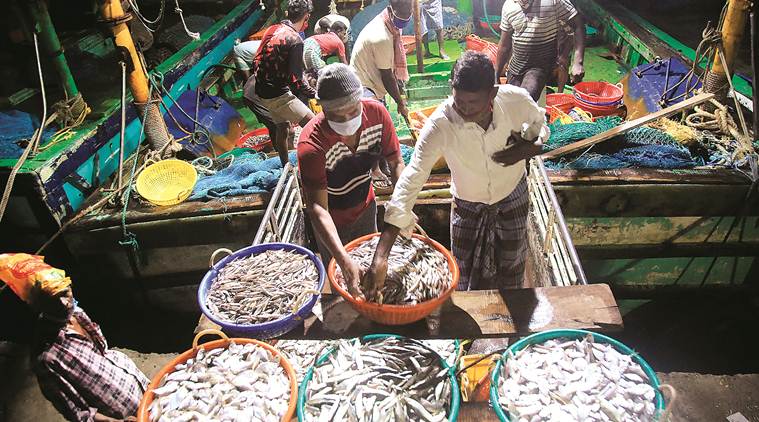 Fishermen from Chinna Muttam Fishing Harbour arrive to sell fish in Kanyakumari. (PTI)
Fishermen from Chinna Muttam Fishing Harbour arrive to sell fish in Kanyakumari. (PTI)
A testing programme necessary for lifting India’s lockdown would cost less than 2.1 per cent of the lockdown’s economic losses, researchers from India School of Business and Imperial College have found.
In another metric, the study found that “a resource-intensive (testing) strategy … corresponds to less than half of the lockdown-caused loss in goods and services tax (GST) revenue.”
The pre-print study states that if 20 per cent of the population has Covid-19 antibodies (known as sero-prevalence) by the time lockdown is lifted, then authorities would need to identify and isolate symptomatic cases within five to eight days of their symptoms to prevent an overwhelmed healthcare capacity.
Using this goalpost, a testing programme cost of $26.68 million to $42.12 million (Rs 200 crore to 317 crore) per week could identify cases within five days of their symptoms being identified. The study has determined RT-PCR test costs between $34.1 and $53.8 (Rs 2,500 to Rs 4,000).
The study has estimated the lockdown’s economic loss at $1,372 million to $1,979 million (Rs 10,000 crore to 14,900 crore) per week for one city. This is due to a 58 to 83.4 per cent productivity loss.
To estimate economic loss, the researchers combined productivity cost of each sector according to a mega-city similar to Delhi.
Along with operations management and public health faculty, the paper’s lead author, Sandip Mandal, had also led a highly-cited Indian Council of Medical Research (ICMR) epidemic modeling and strategy paper in late-March.
The researchers encourage the government to focus on antibody testing to gauge the required speed of trace and isolation measures that would control the outbreak and allow for a relaxed lockdown. However, the study calls for this process to be implemented two weeks before a lockdown is lifted.
As the country enters into its first “unlock” phase, the ICMR has yet to receive all results from its nationwide sero-survey, and on May 30 advised states to initiate their own. Several states (Delhi, Gujarat, Jharkhand, Maharashtra, and West Bengal) are testing far fewer contacts per confirmed case than the national level, according to an article in the ‘Indian Journal of Medical Research’ released on May 29.
“Essentially, testing offers a means for moving from a blanket lockdown to targeted quarantine, more so for urban areas with high transmission probability in densely populated pockets. However…how can health authorities assess whether cases in the community are being identified and isolated sufficiently rapidly, to safely lift the lockdown,” the study asked.
It reported, “In the early days of the pandemic, India was amongst several countries (including the US) facing an acute shortage of testing capacity, rendering it infeasible to perform intensive testing at the community level…. In particular, (sero-prevalence) provides an estimate of the fraction of the population that could still support transmission if the lockdown were lifted. In turn, the information from sero-surveillance can inform the intensity of effort that is needed, by any RT-PCR-based test-and-isolate strategy that aims to suppress transmission.”
In a recent Harvard University roadmap for testing, several institutions came together to call for 5 million tests per day by early June and 20 million a day by late July in order to reopen most activities by August.
This paper similarly calls for a combination of antibody and RT-PCR testing as well as a Pandemic Testing Board to handle supply chain.